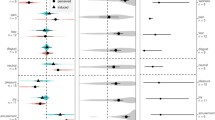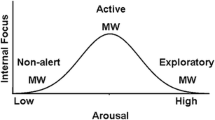Abstract
Psychological research on the pupillary response since 1960 has focused on an arousal interpretation and a cognitive interpretation. Experiment 1 was an attempt to manipulate some arousal factors while controlling the cognitive demands of the task. Pupil size was cinematographically recorded while subjects who had different degrees of reported fear of snakes listened to passages describing imagined interactions with a snake in different proximities. There was also a set of control passages that made no mention of snakes but were otherwise semantically and syntactically identical to the aversive passages. The pupillary response showed no influence of the arousal manipulations, but rating and behavioral data indicated that the arousal variables had been effective. The cognitive demands of the task were clearly indicated by the pupillary response. In Experiment 2 two types of tasks were used: one that employed both arousal (incentive) and cognitive factors and another that had an arousal manipulation (threat of shock) but no explicit cognitive demands. The pupil response was recorded as well as heart rate, skin conductance, and EMG. The pupillary response showed an effect of the arousal manipulations only when cognitive demands were minimal. The results of both experiments are consistent with the view that cognitive demands take priority over arousal factors in affecting the pupillary response. Heart rate did show arousal effects that were not preempted by cognitive demands.
Similar content being viewed by others
References
Elliot, R. The motivational significance of heart rate. In P. Obrist, M. H. Black, J. Brener, & L. DiCara (Eds.),Cardiovascular psychophysiology. Chicago: Aldine, 1974.
Fisher, S.Body experience in fantasy and behavior. New York: Appleton-Century-Crofts, 1970.
Fisher, S., & Cleveland, S. E. A comparison of psychological and physiological reactivity in ulcer and rheumatoid arthritis groups.Psychosomatic Medicine 1960,22 290–293.
Geisser, S., & Greenhouse, S. W. An extension of Box's results of the use of theF distribution in multivariate analysis.Annals of Mathematical Statistics 1958,29 885–891.
Goldwater, B. C. Psychological significance of pupillary movements.Psychological Bulletin 1972,77 340–355.
Hess, E. H. Attitude and pupil size.Scientific American 1965,212 46–54.
Hess, E. H. Pupillometrics: A method of studying mental, emotional, and sensory processes. In N. S. Greenfield & R. A. Sternbach (Eds.),Handbook of psychophysiology. New York: Holt, 1972.
Hess, E. H., & Polt, J. M. Pupil size as related to interest value of visual stimuli.Science 1960,132 349–350.
Hess, E. H., & Polt, J. M. Pupil size in relation to mental activity during simple problem solving.Science 1964,143 1190–1192.
Janisse, M. P. Pupil size and affect: A critical review of the literature since 1960.Canadian Psychologist 1973,14 311–329.
Kahneman, D.Attention and effort. Englewood Cliffs, New Jersey: Prentice-Hall, 1973.
Kahneman, D., & Beatty, J. Pupil diameter and load on memory.Science 1966,145 1583–1585.
Kahneman, D., & Peavler, W. S. Incentive effects and pupillary changes in association learning.Journal of Experimental Psychology 1969,79 312–318.
Kahneman, D., Peavler, W. S., & Onuska, L. Effects of verbalization and incentive on the pupil response to mental activity.Canadian Journal of Psychology 1968,22 186–196.
Kahneman, D., Tursky, B., Shapiro, D., & Crider, A. Pupillary, heart rate and skin resistance changes during a mental task.Journal of Experimental Psychology 1969,79 164–167.
Liberman, A. E. Some new data on the pupillary component in man. In L. G. Veronin, A. N. Leontiev, A. R. Luria, E. N. Sokolov, & O. S. Vinogradova (Eds.),Orienting reflex and exploratory behavior. Washington D.C.: American Institute of Biological Sciences, 1965.
Loewenfeld, I. E. Comment on Hess's findings.Survey of Opthalmology 1966,11 291–294.
Lowenstein, O., & Loewenfeld, I. E. The pupil. In H. Davson (Ed.),The eye. New York: Academic Press, 1962.
Moos, R. H., & Engel, B. T. Psychophysiological reactions in hypertensive and arthritic patients.Journal of Psychosomatic Research 1962,6 227–241.
Nunnally, J. C., Knott, P. D., Duchnowski, A., & Parker, R. Pupillary response as a general measure of activation.Perception and Psychophysics 1967,2 149–155.
Paivio, A., & Simpson, H. M. The effect of word abstractness and pleasantness on pupil size during an imagery task.Psychonomic Science 1966,5 55–56.
Polt, J. M. Effect of threat of shock on pupillary response in a problem-solving situation.Perceptual and Motor Skills 1970,31 587–593.
Simpson, H. M., & Molloy, F. M. Effects of audience anxiety on pupil size.Psychophysiology 1971,8 491–496.
Stanners, R. F., & Headley, D. B. pupil size and instructional set in recognition and recall.Psychophysiology 1972,9 505–511.
Stanners, R. F., Headley, D. B., & Clark, W. R. The pupillary response to sentences: Influences of listening set and deep structure.Journal of Verbal Learning and Verbal Behavior 1972,11 257–263.
Vacchiano, R. B., Strauss, P. S., Ryan, S., & Hochman, L. Pupillary response to value linked words.Perceptual and Motor Skills 1968,27 207–210.
Wolpe, J., & Lazarus, A. A.Behavior therapy techniques. New York: Pergamon, 1966.
Woodmansee, J. J. Methodological problems in pupillographic experiments.Proceedings of of the 74th Annual Convention of the American Psychological Association, 1966, 133–134.
Wright, P., & Kahneman, D. Evidence for alternative strategies of sentence retention.Quarterly Journal of Experimental Psychology 1971,23 197–213.
Author information
Authors and Affiliations
Rights and permissions
About this article
Cite this article
Stanners, R.F., Coulter, M., Sweet, A.W. et al. The pupillary response as an indicator of arousal and cognition. Motiv Emot 3, 319–340 (1979). https://doi.org/10.1007/BF00994048
Issue Date:
DOI: https://doi.org/10.1007/BF00994048




